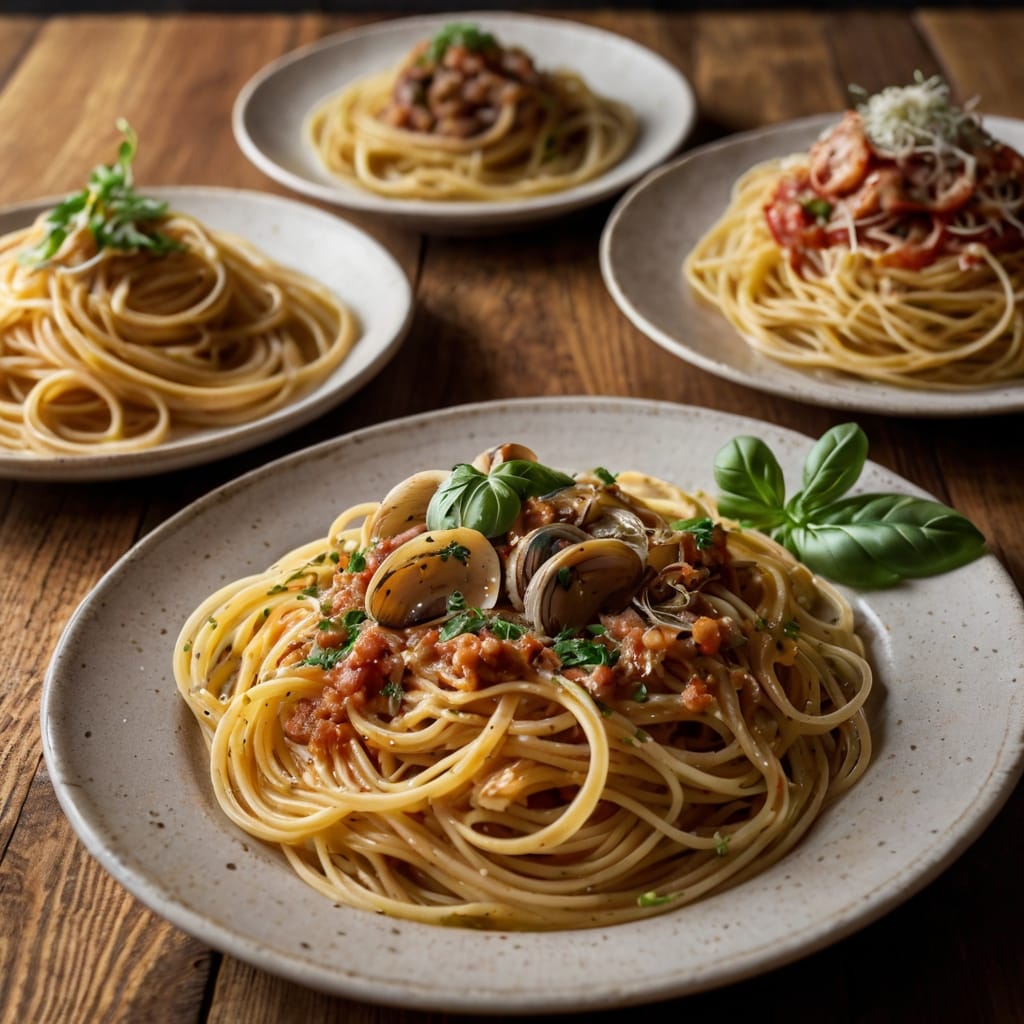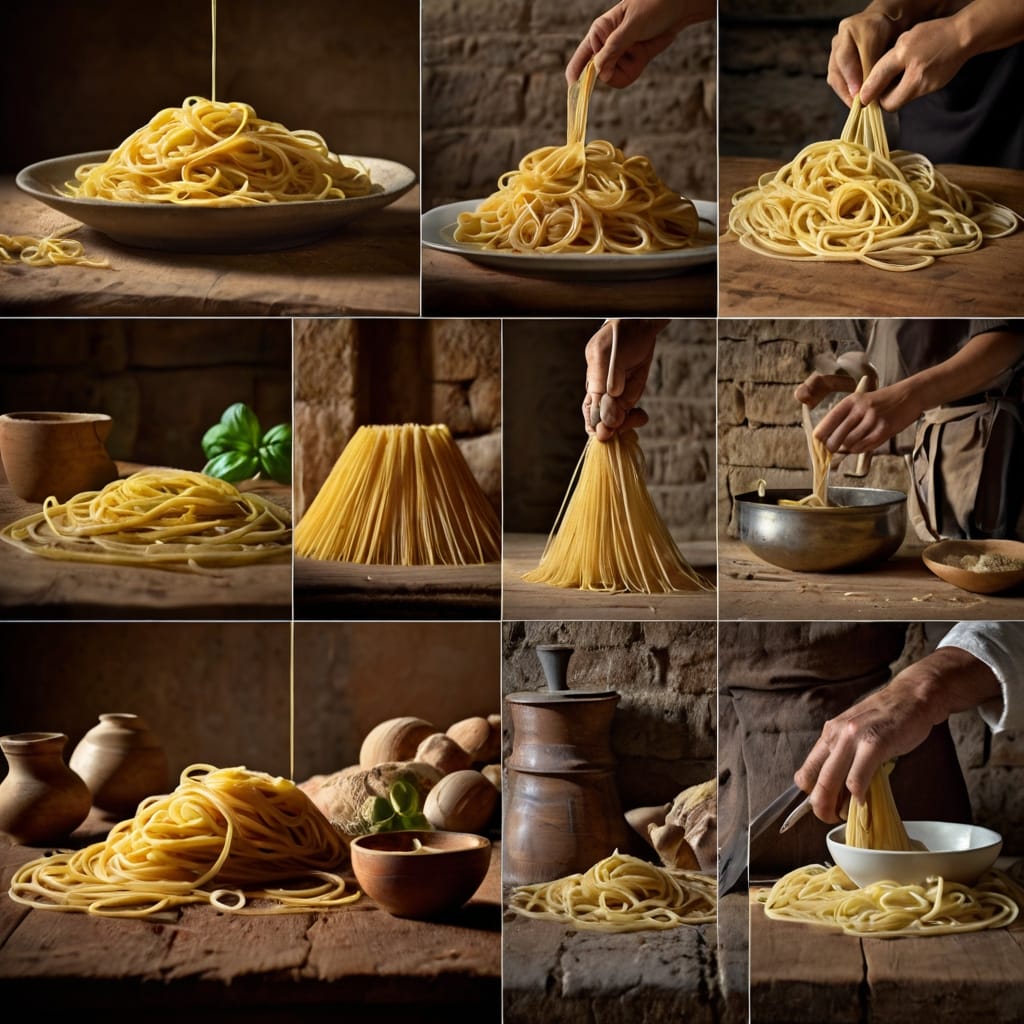Years ago, during a family reunion in Sicily, I discovered something fascinating about the history of spaghetti pasta and its journey through time. My nonna sat us down and shared tales of her childhood spent rolling pasta dough with her mother. As her hands glided across the table, she spoke of ancient recipes and traditions passed down through generations. It was then that I realized spaghetti wasn’t just food; it was a thread connecting us to our past.
From the crowded bazaars of ancient Rome to the bustling kitchens of American homes, spaghetti has seen an incredible evolution. How did a simple pasta dish become a global sensation?
Join me on this culinary journey as we uncover the secrets and stories behind Italian cuisine’s beloved spaghetti.
Origins of Spaghetti: Myth or Reality?
The journey to uncover the true origins of spaghetti is fascinating. Let’s delve into the legends, historical contributions, and cultural influences that shaped this iconic dish.
The Legend of Marco Polo
One of the most popular pasta myths surrounds Marco Polo spaghetti. It’s often said that Marco Polo introduced pasta to Italy after his travels through China. However, there’s only limited evidence to support this claim.
While his journeys did encourage cultural exchange, spaghetti might have already been known in Italy.
Ancient Roman Contributions
Long before Marco Polo, Roman gastronomy played a crucial role in shaping early pasta dishes. Ancient texts mention “lagana,” a dish made from wheat flour and water, bearing resemblance to modern-day spaghetti.
The Romans’ culinary practices, therefore, are essential when exploring the history of pasta.
Early Mediterranean Influences
The Mediterranean diet, rich in grains and fresh ingredients, further influenced spaghetti’s origins. Trade and cultural exchanges in the Mediterranean region led to the spread of pasta-like dishes.
This interaction among coastal civilizations created fertile ground for the spaghetti we enjoy today.
The Evolution of Spaghetti in Italy
The culinary transformation of Italian spaghetti from humble beginnings to a beloved staple in fine dining took centuries. Initially, spaghetti graced Italian streets as an inexpensive street food that anyone could enjoy.
From Street Food to Fine Dining
Neapolitan street vendors sold spaghetti in simple paper cones, making it accessible to the masses. Over time, Italian spaghetti found its way to upscale tables. The integration of high-quality ingredients and refined cooking techniques elevated it to gourmet status.
Chefs embraced this transformation, infusing each dish with local flavors, turning it into a symbol of Italy’s rich culinary traditions.

Regional Variations
Italy’s diverse landscape and regional produce offer a plethora of spaghetti varieties. Each region boasts unique pasta dishes that reflect its heritage and local ingredients.
For instance, Naples popularized spaghetti alle vongole, while Bologna became famous for spaghetti alla bolognese. These regional pasta dishes highlight how local traditions shape the Italian spaghetti experience.
The deep connection between regional ingredients and culinary techniques showcases the inventiveness and adaptability of Italian cuisine, making every spaghetti dish a journey through Italy’s gastonomic heritage.
The Global Spread of Spaghetti
The history of spaghetti pasta found its way across borders thanks to Italian immigrants. They carried their beloved pasta recipes to new lands, spreading spaghetti’s popularity far and wide.
As Italians settled in places like the United States, Argentina, and Australia, their culinary traditions mingled with local flavors. This fusion gave birth to new dishes, cementing spaghetti’s role in international cuisine.
Global trade and mass production also played a key role. With industrial advancements, spaghetti became more accessible to people around the world. It wasn’t long before it joined the ranks of global pasta trends, enjoyed by millions.
- Italian immigrants brought spaghetti to new corners of the world.
- Spaghetti adapted to local ingredients, creating unique dishes.
- Advancements in trade and production made spaghetti widely available.

Spaghetti in American Culture
The journey of spaghetti across continents finds a warm embrace in American culture. When Italian immigrants brought their culinary traditions to the United States, spaghetti quickly became a staple in Italian-American food, blending authentic recipes with local influences. The result? A delicious evolution of dishes that have become household favorites across the nation.
The Rise of Italian-American Cuisine
Italian-American cuisine blossomed through the early 20th century as immigrants adapted their traditional meals using available ingredients. Spaghetti with meatballs is a prime example of this culinary innovation. It was a fusion of Italian pasta traditions and American love for hearty, protein-rich meals.
This delectable dish showcased how spaghetti could seamlessly blend into American dining while retaining its authentic roots.
Spaghetti Collaborations
Spaghetti’s versatility has led to various collaborations in the culinary world. Chefs across America experiment with it, blending flavors from different cultures. Take, for instance, the combination of spaghetti with Asian-inspired sauces or integrating it into Mexican dishes.
These spaghetti collaborations highlight the pasta’s adaptability and universal appeal, resulting in mouth-watering, eclectic creations that continue to surprise and delight.
Spaghetti in Pop Culture
Beyond the plate, spaghetti has cemented its place in pop culture. From the iconic “Lady and the Tramp” spaghetti scene to references in songs, TV shows, and films, pasta in media reflects its significant impact.
These appearances symbolize comfort, romance, and family, elevating spaghetti from a mere dish to a cultural icon deeply embedded in the American psyche.
FAQ
What is the history of spaghetti pasta?
The history of spaghetti pasta is a fascinating culinary journey that traces its origins back to the Mediterranean basin and the Middle East. Historical texts and archaeological findings reveal tools and ingredients used in ancient pasta production, showcasing the evolution of this beloved dish through time.
Did Marco Polo really introduce spaghetti to Italy?
The legend of Marco Polo bringing spaghetti to Italy is a popular myth. While some believe that his travels introduced pasta from China, historical evidence points to ancient Roman contributions and early Mediterranean influences as the true origins of spaghetti.
How did spaghetti evolve from street food to fine dining in Italy?
Spaghetti’s transformation from humble Neapolitan street food to gourmet cuisine in Italy is well documented. Historical accounts highlight the culinary evolution and the impact of local ingredients and traditions across various Italian regions.
What are some regional variations of spaghetti dishes in Italy?
In Italy, regional variations of spaghetti dishes abound. Each region brings its own unique touch, influenced by local ingredients and culinary traditions. Examples include spaghetti alla Carbonara from Rome, spaghetti alle Vongole from Naples, and spaghetti alla Norma from Sicily.
How did spaghetti become popular worldwide?
The global spread of spaghetti can be attributed to Italian immigrants introducing it to other countries and global trade facilitating mass production. Spaghetti has become an integral part of international cuisine, enjoying popularity in numerous cultures.
What role does spaghetti play in Italian-American cuisine?
Spaghetti holds a central role in Italian-American cuisine, marking the rise of beloved dishes like spaghetti and meatballs. Historical narratives highlight how Italian immigrants adapted traditional recipes, creating a unique and cherished culinary tradition in America.
Can you give examples of spaghetti in pop culture?
Spaghetti has made its mark in pop culture through references in American film, TV, and music. Iconic scenes from movies like ‘The Godfather’ and ‘Lady and the Tramp’, along with mentions in songs and TV shows, showcase its cultural impact and popularity.

